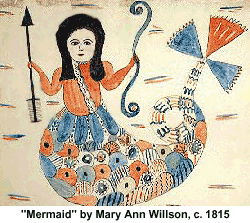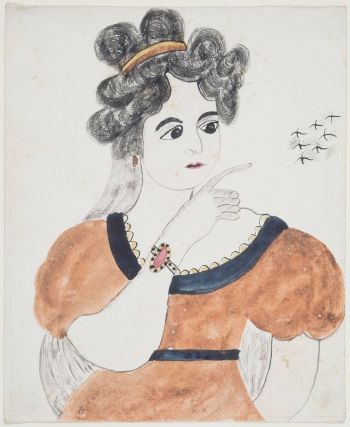Jonathan Ned Katz: "Miss Willson and Miss Brundage", early 1800s
Admirer of Art's Account
In America, in the early years of the 19th century, wrote a reporter from that time, "two maids left their home in the East with a romantic attachment for each other" that continued for "many years."
"Miss [Mary Ann] Willson and her friend Miss Brundage" reportedly bought a few acres and lived in a log house in the town of Greenville, Green County, N.Y., a rural community of hardworking settlers.
Miss Brundage was "the farmer and cultivated the land by the aid of neighbors, occasionally doing some plowing for them!" She "planted, gathered in, and reaped." Miss Willson "made pictures. which she sold to the farmers as rare and unique 'works of art.'"
Our reporter, identified only as "an admirer of art," wrote two accounts of Miss Willson and Miss Brundage. Admirer called the pair "my friends," often visited them, and wrote about them 50 years after those visits.
Admirer tells us that Willson's paints were "of the simplest kind," made from berries and bricks. "Occasional 'stove paint' "was also used to create Willson's "elegant designs."
The reporter, referring to Willson and Brundage, "takes great pleasure in testifying to their simplicity and originality of character their unqualified belief that these 'pictures' were very beautiful"--and their even "boasting how greatly they were in demand." The pair were quoted as having said that the pictures "go way to Canada and clear to Mobile!" We can almost hear the women boasting!
The good-hearted Admirer ends by asking us to let all Willson's and Brundage's "imperfections be buried in their graves and shield these and them from other than kindly criticism."
The "imperfections" referred to may be the women's boastfulness and the untutored quality of Willson's art--not anything illicit about their romance. For Admirer, romantic friendship between women was probably not yet suspect as sexual.
Admirer says that the two women lived in Green County "until the death of the 'farmer maid,'" Brundage, at which Willson "was inconsolable and, after a brief time, removed to parts unknown."
De Lisser's Account
In 1894, a Green County historian, R. Lionel De Lisser, published Picturesque Catskills and altered significantly the story of Willson and Brundage's intimacy. Quite possibly, this was to quiet growing suspicions in 1890s America about an illicit eros in romantic attachments between women.[1]
De Lisser says that Willson and Brundage "had both of them, in their younger days, experienced a romance [with a male, he presumed] that had broken their hearts, and the bond of sorrow between them had drawn the two close to each other in womanly sympathy." Though the two were "supposed to be sisters," they were "not related by ties of blood in any way." The two had left their own country for Connecticut and then moved to Green County, "seeking peace and forgetfulness in the wilderness."
De Lisser suggests that Willson and Brundage worked together in their "log house and garden, which was filled with wildflowers and ferns, and in painting watercolor pictures." The wildflowers and ferms are a lovely image.
Jonathan Ned Katz Comments
We know about Willson's paintings because a portfolio of them and Admirer's account were discovered in 1944, during a resurgence of interest in American folk artists. (Admirer's second account was found in 1967.) In 1976, a student of American folk art called Willson "one of the most original early 19th-century watercolorists yet discovered."
Willson's paintings of women, reproduced here, indicate her fresh, spontaneous style. If circles are female sexual symbols, her mermaid's lower torso is definitely female and sexual. Could her mermaid, usually presented as the legendary seductress of men, be inspired by Miss Brundage? No man is in sight.
The exhibit label on the original mermaid painting at the Fenimore Art Museum, Cooperstown, NY, says:
- Her Maremaid resembles the subject of an 18th-century trade sign and trade card from London. Brandishing a weapon in each hand, rather than a mirror and comb, as in the London images, Willson's ideal appears to combine attributes of the Amazon with those of the mermaid.
Alma Routsong
In the 196Os, one modern woman was seduced by Willson's mermaid. In an interview printed in Gay American History, novelist Alma Routsong told how, in a little museum in Cooperstown, N.Y. she suddenly heard this Circe's call.
Routsong was wandering through the museum "When my lover said: 'Psst, psst!' and called me back, pointing to this picture of a mermaid by Mary Ann Willson. There was a card beside it that said Miss Willson and her 'farmerette' companion lived and worked together in Greenville Town, Greene County, New York, circa 1820."[2] If there's any doubt about the importance of museum placards, this should put an end to it.
The novelist's imagination was stirred. Supported financially by her lover, Routsong went on to write and privately publish (under the name Isabel Miller) her fictional account of Willson and Brundage. The charming lesbian-feminist novel was later republished commercially as Patience and Sarah.[3]
Since she could discover little historical evidence about the real Willson and Brundage, Routsong was forced to imagine most details of her characters' lives. Her novel stands today as a delightful, creative transformation of lesbian history into lesbian fiction.
See also:
Alma Routsong: "Patience and Sarah," 1962-1972
Additional sources
Lipman, Jean, and Alice Winchester, Primitive Painters in America; 1750-1950 (N.Y.: Dodd Mead, 1950), p. 53. Chap. 6 (by Lipman) is devoted to Willson: p. 50-56.
Lipman, Jean, and Mary C. Black, American Folk Painting (N.Y.: C. N. Potter, 1966), reference to Willson page ?.
Routsong, Alma. (Isabel Miller, pseud.). Interviewed by Jonathan Ned Katz, N.Y.C.: Jan. 20, 1975.
Routsong, Alma. Patience and Sarah. <publication data?>
United States of America. National Gallery of Art. Mary Ann Willson Paintings and Information.
Willson, Mary Ann. Paintings. In The New York State Historical Association, Cooperstown, New York.
Notes
- ↑ The late-19th century suspicion of a sexual component has been written about by many historians.
- ↑ The quote is from Katz's interview with Routsong: see Alma Routsong: "Patience and Sarah," 1962-1972.
- ↑ This entry is re-edited by Katz from his original article, which appeared in The Advocate, December 5, 1988, pages 45-46.
The mermaid painting is at the Fenimore Art Museum, Cooperstown, NY. The information about it provided by that museum reads:
Object ID N0085.1961
Title Maremaid
Artist Willson, Mary Ann
Object Name Painting
Early Date 1810
Late Date 1820
Exhibit label: The mermaid is most widely seen in Germanic decorative arts. Willson's depiction might indicate that she was aware of Germanic decorative traditions, but her heritage is more likely English. Her Maremaid resembles the subject of an 18th-century trade sign and trade card from London. Brandishing a weapon in each hand, rather than a mirror and comb, as in the London images, Willson's ideal appears to combine attributes of the Amazon with those of the mermaid.
Description Marks: In pencil at bottom edge: "Maremaid"
Dimensions H-13 W-16 inches
Material Watercolor on paper
Place of Origin Greene County, NY
Last Edit: Feburary 9, 2011, 7:03 pm.

